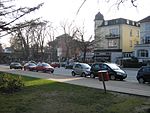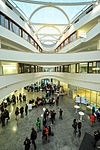Netzwelt
1999 establishments in GermanyGerman news websitesInternet properties established in 1999Mass media in HamburgOnline computer magazines ... and 1 more
Technology blogs

Netzwelt (own writing: netzwelt) is a technology-related news website run by Netzwelt GmbH. The two founders, Dirk and Sascha Hottes, founded Netzwelt in early 1999 in Darmstadt. The site, which bills itself as "Guter Rat auf einen Klick" (Good advice at a click), features consumer electronics and software, as well as user-generated content in a popular forum. With up to 4,8 million visitors and 18 million page impressions, Netzwelt is one of the top five IT websites in Germany, Austria and Switzerland.
Excerpt from the Wikipedia article Netzwelt (License: CC BY-SA 3.0, Authors, Images).Netzwelt
Osdorfer Landstraße, Hamburg Bahrenfeld (Altona)
Geographical coordinates (GPS) Address Nearby Places Show on map
Geographical coordinates (GPS)
| Latitude | Longitude |
|---|---|
| N 53.571230555556 ° | E 9.8714833333333 ° |
Address
Osdorfer Landstraße 20
22607 Hamburg, Bahrenfeld (Altona)
Germany
Open on Google Maps









